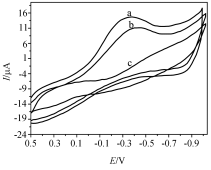1. Wang, M.; Liang, Y.-S.; Li, Q.-Q. PTCA Part B: Chem. Anal. 2000, 36(12), 564 (in Chinese). (王铭, 梁云生, 李箐箐, 理化检验-化学分册, 2000,36(12), 564.)

2 Tang, Z.-X. Shenyang Chem. Ind. 2000, 29(4), 235 (in Chinese). (唐祝兴, 沈阳化工, 2000, 29(4), 235.)
3 Wang, J.-Y.; Chen, J.-X.; Wang, Y. Yunnan. Metall. 2003,32(5), 46 (in Chinese). (王劲榕, 陈加希, 王英, 云南冶金, 2003, 32(5), 46.)

4 Wang, J.-P. PTCA Part B: Chem. Anal. 2005, 41(11), 741 (in Chinese). (王京平, 理化检验-化学分册, 2005, 41(11), 741.)
5 Zhuo, Y.-R.; Luo, S. Hunan Nonferrous Metals 2006, 22(1),60 (in Chinese). (卓毓瑞, 罗丝, 湖南有色金属, 2006, 22(1), 60.)
6 Kolthoff, I. M.; Furman, N. H. Potentiometric Titrations, Wiley, New York, 1931, p. 108.
7 Kriowa, E.; Golombek, A.; Ariel, M. J. Electroanal. Chem. Interfacial Electrochem. 1968, 16, 33.

8 Umland, F.; Schumacher, E. 分析化學(日文), 1981, 30(9), S1 (in Japanese).
9 Gao, H. Oscillography Titration, Nanjing University Press, Nanjing, 1994, pp. 431~571 (in Chinese). (高鸿, 示波滴定, 南京大学出版社, 南京, 1994, pp.431~571.)
10 Gao, H. Oscillography Drug Analysis, Sichuan Education Press, Chengdu, 1992, pp. 104~428 (in Chinese). (高鸿, 示波药物分析, 四川教育出版社, 成都, 1992, pp.104~428.)
11 Zhang, S.-Y.; Guang, S.-Y.; Kong, X.-T.; Tang, B. J. China Univ. Sci. Technol. 1999, 29(3), 373 (in Chinese). (张胜义, 光善仪, 孔祥泰, 唐波, 中国科学技术大学学 报, 1999, 29(3), 373.)
12 Bu, H.-Z.; Gao, H. Chem. J. Chin. Univ. 1998, 9(4), 323 (in Chinese). (卜海之, 高鸿, 高等学校化学学报, 1998, 9(4), 323.)

13 Xing, B.-Z.; Weng, Y.-R.; Zhu, J.-J.; Gao, H. Chem. J. Chin. Univ. 1991, 12(2), 186 (in Chinese). (刑宝忠, 翁筠蓉, 朱俊杰, 高鸿, 高等学校化学学报,1991, 12(2), 186.)

14 Xu, W.-J.; Gao, H. Acta Chim. Sinica 1989, 47, 42 (in Chinese). (徐伟健, 高鸿, 化学学报, 1989, 47, 42.)
15 Zheng, J.-B.; Tao, F.-F. Chin. J. Appl. Chem. 2005, 22(6),595 (in Chinese). (郑建斌, 陶福芳, 应用化学, 2005, 22(6), 595.)

16 Zheng, J.-B.; Ni, H.-G.; Zhang, H.-F. Chin. J. Appl. Chem.2005, 22(7), 726 (in Chinese). (郑建斌, 倪宏刚, 张宏芳, 应用化学, 2005, 22(7), 726.)

17 Qi, T.-X. PTCA Part B: Chem. Anal. 2007, 43(11),934 (in Chinese). (齐同喜, 理化检验-化学分册, 2007, 43(11), 934.)

18 Qi, T.-X. PTCA Part B: Chem. Anal. 2007, 43(4), 323 (in Chinese). (齐同喜, 理化检验-化学分册, 2007, 43(4), 323.)

19 Qi, L.; Qi, T.-X. Metall. Anal. 2010, 30(4), 32 (in Chinese). (齐蕾, 齐同喜, 冶金分析, 2010, 30(4), 32.)
20 Chang, W. B.; Li, K. A. Concise Analytical Chemistry Manual, Peking University Press, Beijing, 1999, p. 512 (in Chinese). (常文保, 李克安, 简明分析化学手册, 北京大学出版社, 北京, 1999, p. 512.)
21 Zhu, J. J.; Yao, D. Q.; Lu, B. Z.; Gao, H. Chem. J. Chin. Univ. 1993, 14(5), 614 (in chinese). (朱俊杰, 姚大庆, 卢宝柱, 高鸿, 高等学校化学学报,1993, 14(5), 614.)












